Optimizing Virtual Power Plants with Parallel Simulated Annealing on High-Performance Computing
Abstract
Highlights
- A novel parallelized SA algorithm was developed and implemented by using OpenMP on HPC infrastructure, delivering a substantial reduction in computational time for VPP scheduling.
- The approach showcases significant scalability, efficiently optimizing large-scale VPP networks with up to 512 prosumers, ensuring that the system remains robust as network complexity and size increase.
- By achieving near-linear speedup ratios across up to 32 cores, the algorithm leverages parallel computing to accelerate decision-making processes in real-time energy markets.
- The study integrates critical operational constraints, such as battery lifespan limitations and dynamic energy pricing, enabling sustainable and adaptive energy management while maintaining high-quality optimization outcomes.
- Extensive simulations demonstrate the effectiveness of the proposed framework in balancing energy acquisition, storage, and dispatch decisions across diverse DERs, contributing to smarter energy distribution systems.
- The enhanced computational efficiency and scalability of the parallelized SA approach make it a practical and advanced solution for real-time VPP scheduling, ensuring reliable and adaptive energy management in dynamic market environments.
- This framework supports the development of future smart city energy systems—as evidenced by its strategic deployment in Portugal in the national project New Generation Storage (NGS)—by enabling the seamless integration of renewable energy sources, electric vehicles, and energy storage systems, ultimately contributing to a resilient, low-carbon energy ecosystem.
- By optimizing energy distribution with a focus on maximizing social welfare, the framework aligns with the principles of economic sustainability, grid stability, and environmental responsibility in smart cities.
- The findings highlight the transformative role of HPC and parallel computing in addressing the growing complexity of energy systems, providing a scalable and efficient blueprint for enhancing energy optimization and distribution in urban settings.
Abstract
1. Introduction
2. Related Works
2.1. Optimization Strategies for Virtual Power Plants
2.2. Parallel Computing for VPP Optimization
2.3. Role of High-Performance Computing (HPC) in Advanced VPP Scheduling
3. Methodology
3.1. Problem Description
- Rolling-based Social Welfare Optimization: The primary goal is to maximize social welfare by scheduling energy transactions in a way that meets the collective needs of the grid and prosumers. This optimization is conducted on a rolling basis, allowing the model to respond dynamically to real-time changes in demand and supply, ensuring alignment with current market dynamics. By reformulating the problem as a minimization objective, the framework incorporates broader considerations, such as battery utilization and operational costs, ensuring that social welfare is achieved while maintaining efficiency and cost-effectiveness across the system.
- Scalability to Accommodate Expanding Market Demand: The framework must scale efficiently with an increasing number of prosumers, preserving computational efficiency and execution timeliness as the participant count grows. This scalability is essential to upholding the system’s performance standards within an expanding VPP market.
- Battery Health Constraints: To ensure the long-term operational viability of prosumer batteries, the optimization incorporates constraints that regulate battery charge and discharge cycles. These constraints maintain battery states within defined limits, promoting sustainable energy practices and prolonging battery life.
- Grid-Determined Pricing and Quantity-Based Scheduling: In this scenario, electricity prices are determined by the grid, with no price offers from prosumers. The optimization aligns each prosumer’s transactions with these predefined price signals, allowing prosumers to submit only the quantities they can generate or consume. This ensures a streamlined, price-sensitive scheduling approach within the VPP market.
3.2. Problem Formulation
3.3. Parameters and Variables
3.3.1. Objective Function
3.3.2. Energy Balance Constraints
3.3.3. Acquisition and Dispatch Decision Constraints
3.3.4. Dispatch Breakdown
- : paid energy dispatch at time t.
- : non-paid energy dispatch at time t.
3.3.5. Battery Dynamics
3.3.6. Charge and Discharge Constraints
3.3.7. Battery Capacity Constraints
3.4. Problem Exploration and Parallel Computation
3.4.1. Energy Balance with Mutual Exclusivity and Constraints
3.4.2. Mutually Exclusive Flip-Flop Mechanism for Grid and Battery Operations
- enables energy acquisition while setting .
- enables energy dispatch while setting .
- initiates charging while setting .
- initiates discharging while setting .
3.4.3. Upper-Bound Constraints on Energy Flows
3.4.4. Linearized Energy Balance Equation
- -
- represents the player’s net battery activity (charging/discharging).
- -
- represents the net grid interaction (acquisition/dispatch).
- -
- represents the net energy generated or consumed.
3.4.5. Complete Energy Balance with Constraints
3.5. Solver Design and Algorithm Development
3.5.1. Exact Solver
3.5.2. Parallel Simulated Annealing Solver
| Algorithm 1: Simulated annealing with parallel optimization using OpenMP | |
| 1: Input: Initial state , Initial temperature , Cooling rate , Perturbation scale , Number of iterations , Number of players , Number of periods , Battery dynamics, and cost parameters from the input. | |
| 2: Output: Best global state , Best global cost | |
| 3: Initialize: Shared memory for global best state and global best cost to store optimization results. | |
| 4: Initialize temperature , objective function for cost calculation. | |
| 5: #pragma omp parallel for shared() private() reduction(+: ) | // Parallelized loop for each player i |
| 6: for to do | // Each player is solved independently in parallel |
| 7: Initialize local state , local cost | |
| 8: Set , , | |
| 9: Initialize period states for player i across all periods. | |
| 10: Calculate initial battery state based on input parameters and previous period states. | |
| 11: for to do | // Iterative optimization process |
| 12: for to do | // Optimize for each period t for player i |
| 13: Perturb player state for period t using | |
| 14: Compute new balance for the player, update charge/discharge states | |
| 15: Calculate new battery state for period t | |
| 16: end for | |
| 17: Compute new cost | // Moved outside of inner loop |
| 18: Calculate acceptance probability | |
| 19: if then | // Random value |
| 20: Update | |
| 21: if then | |
| 22: Update | |
| 23: end if | |
| 24: end if | |
| 25: Apply cooling schedule: | |
| 26: end for | |
| 27: Update global cost using OpenMP reduction. | |
| 28: end for | |
| 29: Return: Best global state , Best global cost | |
3.6. Experimental Design for High-Performance Computing
- Number of cores: Experiments were conducted with the number of CPU cores varying from 1 to 32. This range allows us to evaluate the performance gains from parallelization at different levels of computational resources.
- Number of players (prosumers): To simulate the scalability of the algorithm in larger VPP markets, we varied the number of players from 32 to 512. This variable directly influences the complexity of the optimization problem, as each player requires independent state updates and balancing within the SA framework.
- Averaged execution time (in seconds): This metric records the average time required to execute the SA algorithm across different core and player configurations. By observing how execution time scales with the number of cores and players, we assess the algorithm’s computational efficiency and identify any diminishing returns in speedup with the increase in cores.
- Speedup ratio: The speedup ratio is calculated as the ratio of execution time on a single core to that on multiple cores, providing a normalized measure of performance gain from parallelization. This metric is crucial to understanding the algorithm’s scalability in high-performance environments, particularly for identifying bottlenecks and parallel efficiency under increased core utilization.
3.6.1. Experimental Procedure
3.6.2. Analysis and Interpretation
4. Implementation
4.1. HPC Environment Specifications
4.2. Model Parameters and Outputs
4.2.1. Model Input Parameters
4.2.2. Optimization Outputs
4.3. Hyperparameter Optimization
4.3.1. Parameter Ranges and Search Strategy
- Initial temperature: Varied from to , it controls the acceptance of worse solutions in the early iterations. Higher initial temperatures, closer to , allow for broader exploration by increasing the probability of accepting suboptimal solutions, helping the algorithm escape local minima. As the temperature decreases, this probability decreases, shifting the focus toward refining promising solutions.
- Cooling rate: Varied from to , it determines the rate of temperature reduction throughout the optimization process. A slower cooling rate, near , maintains higher temperatures for longer, promoting diverse solution exploration. Faster rates, closer to , accelerate convergence by focusing on local refinement.
- Perturbation scale: Examined between and , it manages the magnitude of adjustments to the solution in each iteration. Larger perturbations, near , facilitate broad exploration in the early stages, while smaller perturbations, closer to , ensure fine-tuned precision as the algorithm approaches convergence.
4.3.2. Analysis of Results
4.4. Convergence Phases in Simulated Annealing
4.5. Parallelization and Load Balancing Techniques
4.5.1. Thread-Based Parallelization with OpenMP
4.5.2. Unexplored Load Balancing Strategies
4.5.3. Scalability and Computational Efficiency
5. Results and Discussion
5.1. Execution Time and Speedup Analysis
5.2. Scalability Assessment
5.3. Efficiency and Resource Utilization
5.4. Quality of Optimization Outcomes
5.5. Summary of Findings
- Near-ideal speedup ratio:The speedup ratio approached the ideal linear speedup curve, particularly at higher player counts, indicating strong scalability.
- High efficiency and optimal resource utilization: CPU and memory utilization were maintained at efficient levels, supporting stable execution across varied configurations.
- Consistent solution quality: Parallelization did not compromise optimization outcomes, as the parallel SA solver consistently delivered results comparable to the sequential version.
5.6. Application Cases
5.7. Practical Implications for the VPP Market
6. Conclusions and Future Work
Author Contributions
Funding
Data Availability Statement
Acknowledgments
Conflicts of Interest
References
- Podder, A.K.; Islam, S.; Kumar, N.M.; Chand, A.A.; Rao, P.N.; Prasad, K.A.; Logeswaran, T.; Mamun, K.A. Systematic Categorization of Optimization Strategies for Virtual Power Plants. Energies 2020, 13, 6251. [Google Scholar] [CrossRef]
- Nafkha-Tayari, W.; Ben Elghali, S.; Heydarian-Forushani, E.; Benbouzid, M. Virtual Power Plants Optimization Issue: A Comprehensive Review on Methods, Solutions, and Prospects. Energies 2022, 15, 3607. [Google Scholar] [CrossRef]
- Venegas-Zarama, J.F.; Muñoz-Hernandez, J.I.; Baringo, L.; Diaz-Cachinero, P.; De Domingo-Mondejar, I. A Review of the Evolution and Main Roles of Virtual Power Plants as Key Stakeholders in Power Systems. IEEE Access 2022, 10, 47937–47964. [Google Scholar] [CrossRef]
- Ali, J.U.A.B.W.; Kazmi, S.A.A.; Altamimi, A.; Khan, Z.A.; Alrumayh, O.; Malik, M.M. Smart Energy Management in Virtual Power Plant Paradigm with a New Improved Multilevel Optimization Based Approach. IEEE Access 2022, 10, 50062–50077. [Google Scholar] [CrossRef]
- Xie, Y.; Zhang, Y.; Lee, W.-J.; Lin, Z.; Shamash, Y.A. Virtual Power Plants for Grid Resilience: A Concise Overview of Research and Applications. IEEE/CAA J. Autom. Sin. 2024, 11, 329–343. [Google Scholar] [CrossRef]
- Roy, S.; Das, D.C.; Sinha, N. Optimizing Smart City Virtual Power Plants with V2G Integration for Improved Grid Resilience. In Proceedings of the 2024 IEEE International Conference on Interdisciplinary Approaches in Technology and Management for Social Innovation (IATMSI), Gwalior, India, 14–16 March 2024. [Google Scholar] [CrossRef]
- Ou, M.; Huang, G.; Chen, S. Design of a Smart Light Device in Virtual Power Plants for New Energy Regulation. In Proceedings of the 2023 4th International Conference on Advanced Electrical and Energy Systems (AEES), Shanghai, China, 1–3 December 2023. [Google Scholar] [CrossRef]
- Zhang, J.; Seet, B.-C.; Lie, T.T. Dynamic Energy Scheduling for Virtual Power Plant with Prosumer Resources Using Game Theory. In Proceedings of the 2019 IEEE Power & Energy Society General Meeting (PESGM), Atlanta, GA, USA, 4–8 August 2019; pp. 1–5. [Google Scholar] [CrossRef]
- Sousa, T.; Pinto, T.; Morais, H.; Vale, Z. Intelligent Electric Vehicle Heuristic for Energy Resource Management Using Simulated Annealing. In Proceedings of the 2012 3rd IEEE PES Innovative Smart Grid Technologies Europe (ISGT Europe), Berlin, Germany, 14–17 October 2012; pp. 1–8. [Google Scholar] [CrossRef]
- Venegas-Zarama, J.F.; Muñoz-Hernandez, J.I. A General Description of Virtual Power Plants as Smart Manager in Power Systems. In Proceedings of the 2022 IEEE European Technology and Engineering Management Summit (E-TEMS), Bilbao, Spain, 9–11 March 2022; pp. 83–87. [Google Scholar] [CrossRef]
- Pereira, A.; Rodrigues, N.; Barbosa, J.; Leitão, P. Trust and Risk Management Towards Resilient Large-Scale Cyber-Physical Systems. In Proceedings of the 2013 IEEE International Symposium on Industrial Electronics (ISIE), Taipei, Taiwan, 28–31 May 2013; pp. 1–6. [Google Scholar] [CrossRef]
- Alves, F.; Ribeiro, R.; Petiz, M.; Abbasi, A.; Carvalho, P.; Faia, R.; Faria, P.; Vale, Z.; Rodrigues, R. Virtual Power Plant Optimization Service–Benchmark of Solvers. In Proceedings of the 19th Conference on Computer Science and Intelligence Systems (FedCSIS), Belgrade, Serbia, 8–11 September 2024; pp. 279–287. [Google Scholar] [CrossRef]
- Alves, F.; Petiz, M.; Ribeiro, R.; Abbasi, A.; Carvalho, P.N.; Rodrigues, R. An N-Queens Benchmark Using MILP Solvers: Comparison Between Open-Source Optimization Tools. In Optimization, Learning Algorithms and Applications; OL2A 2024. Communications in Computer and Information Science; Springer: Cham, Switzerland, 2024; Volume 2281. [Google Scholar] [CrossRef]
- Aoun, A.; Adda, M.; Ilinca, A.; Ghandour, M.; Ibrahim, H. Optimizing Virtual Power Plant Management: A Novel MILP Algorithm to Minimize Levelized Cost of Energy, Technical Losses, and Greenhouse Gas Emissions. Energies 2024, 17, 4075. [Google Scholar] [CrossRef]
- Lubin, M.; Petra, C.G.; Anitescu, M.; Zavala, V. Scalable Stochastic Optimization of Complex Energy Systems. In Proceedings of the 2011 International Conference for High Performance Computing, Networking, Storage and Analysis (SC), Seattle, WA, USA, 12–18 November 2011; pp. 1–64. [Google Scholar] [CrossRef]
- Sousa, T.; Morais, H.; Vale, Z.; Faria, P.; Soares, J. Intelligent Energy Resource Management Considering Vehicle-to-Grid: A Simulated Annealing Approach. IEEE Trans. Smart Grid 2012, 3, 535–542. [Google Scholar] [CrossRef]
- Sousa, T.; Vale, Z.; Morais, H. Simulated Annealing Approach Applied to the Energy Resource Management Considering Demand Response for Electric Vehicles. In Proceedings of the 17th International Conference on Intelligent System Applications to Power Systems (ISAP), Tokyo, Japan, 1–4 July 2013; pp. 1–6. [Google Scholar]
- Faia, R.; Pinto, T.; Vale, Z. Optimization of Electricity Markets Participation with Simulated Annealing. In Proceedings of the International Conference on Practical Applications of Agents and Multi-Agent Systems (PAAMS), Sevilla, Spain, 1–3 June 2016; Springer: Cham, Switzerland; pp. 27–39. [Google Scholar] [CrossRef]
- Bouddou, R.; Benhamida, F.; Haba, M.; Belgacem, M.; Meziane, M.A. Simulated Annealing Algorithm for Dynamic Economic Dispatch Problem in the Electricity Market Incorporating Wind Energy. Ing. Syst. d’Inf. 2020, 25, 719–727. [Google Scholar] [CrossRef]
- Hannan, M.A.; Abdolrasol, M.G.M.; Faisal, M.; Ker, P.J.; Begum, R.A.; Hussain, A. Binary Particle Swarm Optimization for Scheduling MG Integrated Virtual Power Plant Toward Energy Saving. IEEE Access 2019, 7, 107937–107951. [Google Scholar] [CrossRef]
- Al-Shafei, A.; Zareipour, H.; Cao, Y. A Review of High-Performance Computing and Parallel Techniques Applied to Power Systems Optimization. arXiv 2022, arXiv:2207.02388. [Google Scholar]
- Petra, C.G.; Schenk, O.; Anitescu, M. Real-Time Stochastic Optimization of Complex Energy Systems on High-Performance Computers. Comput. Sci. Eng. 2014, 16, 32–42. [Google Scholar] [CrossRef]
- Angulo, A.; Rodríguez, D.; Garzón, W.; Gómez, D.F.; Al Sumaiti, A.; Rivera, S. Algorithms for Bidding Strategies in Local Energy Markets: Exhaustive Search through Parallel Computing and Metaheuristic Optimization. Algorithms 2021, 14, 269. [Google Scholar] [CrossRef]
- Alvarez, D.; Rodriguez, D.; Rivera, S. Parallel Computing for Reducing Time in Security Constrained Optimal Power Flow Analysis. Rev. Int. Metod. Numer. Calc. Diseño Ing. 2023, 39, 1–5. [Google Scholar] [CrossRef]
- Epperly, T.; Edmunds, T.; Lamont, A.; Meyers, C.; Smith, S.; Yao, Y.; Drayton, G. High-Performance Computing for Electric Grid Planning and Operations. In Proceedings of the 2012 IEEE Power and Energy Society General Meeting, San Diego, CA, USA, 22–26 July 2012. [Google Scholar] [CrossRef]
- Caramanis, M.; Ntakou, E.; Hogan, W.W.; Chakrabortty, A.; Schoene, J. Co-Optimization of Power and Reserves in Dynamic T&D Power Markets with Nondispatchable Renewable Generation and Distributed Energy Resources. Proc. IEEE 2016, 104, 807–836. [Google Scholar] [CrossRef]
- Khan, R.; Islam, N.; Das, S.K.; Muyeen, S.M.; Moyeen, S.I.; Ali, M.F.; Tasneem, Z.; Islam, M.R.; Saha, D.K.; Badal, M.F.; et al. Energy Sustainability—Survey on Technology and Control of Microgrid, Smart Grid, and Virtual Power Plant. IEEE Access 2021, 9, 104663–104694. [Google Scholar] [CrossRef]
- Sarmiento-Vintimilla, J.C.; Torres, E.; Larruskain, D.M.; Pérez-Molina, M.J. Applications, Operational Architectures and Development of Virtual Power Plants as a Strategy to Facilitate the Integration of Distributed Energy Resources. Energies 2022, 15, 775. [Google Scholar] [CrossRef]
- Krishna, R.; Hemamalini, S. Optimal Energy Management of Virtual Power Plants with Storage Devices Using Teaching-and-Learning-Based Optimization Algorithm. Int. Trans. Electr. Energy Syst. 2022, 2022, 1727524. [Google Scholar] [CrossRef]
- Muttaqi, K.M.; Sutanto, D. Adaptive and Predictive Energy Management Strategy for Real-Time Optimal Power Dispatch from VPPs Integrated with Renewable Energy and Energy Storage. IEEE Trans. Ind. Appl. 2021, 57, 1958–1972. [Google Scholar] [CrossRef]
- Naughton, J.; Wang, H.; Cantoni, M.; Mancarella, P. Co-Optimizing Virtual Power Plant Services under Uncertainty: A Robust Scheduling and Receding Horizon Dispatch Approach. IEEE Trans. Power Syst. 2021, 36, 3960–3972. [Google Scholar] [CrossRef]
- Yi, Z.; Xu, Y.; Gu, W.; Wu, W. A Multi-Time-Scale Economic Scheduling Strategy for Virtual Power Plant Based on Deferrable Loads Aggregation and Disaggregation. IEEE Trans. Sustain. Energy 2019, 11, 1332–1346. [Google Scholar] [CrossRef]
- Tang, W.; Yang, H.-T. Optimal Operation and Bidding Strategy of a Virtual Power Plant Integrated with Energy Storage Systems and Elasticity Demand Response. IEEE Access 2019, 7, 79798–79809. [Google Scholar] [CrossRef]
- Lezama, F.; Faia, R.; Soares, J.; Faria, P.; Vale, Z. Learning Bidding Strategies in Local Electricity Markets Using Ant Colony Optimization. In Proceedings of the 2020 IEEE Congress on Evolutionary Computation (CEC), Glasgow, UK, 19–24 July 2020; pp. 1–8. [Google Scholar] [CrossRef]
- Mousavi, S.H.; Nazemi, A.; Hafezalkotob, A. Using and Comparing Metaheuristic Algorithms for Optimizing Bidding Strategy Viewpoint of Profit Maximization of Generators. J. Ind. Eng. Int. 2015, 11, 59–72. [Google Scholar] [CrossRef][Green Version]
- Jain, P.; Saxena, A. Profit Maximization Bidding Strategy for a GENCO Using Whale Optimization Algorithm. In Proceedings of the 2019 Women Institute of Technology Conference on Electrical and Computer Engineering (WITCON ECE), Dehradun, India, 22–23 November 2019; pp. 100–103. [Google Scholar] [CrossRef]
- Rädle, S.; Mast, J.; Gerlach, J.; Bringmann, O. Computational Intelligence Based Optimization of Hierarchical Virtual Power Plants. Energy Syst. 2021, 12, 517–544. [Google Scholar] [CrossRef]
- Peik-Herfeh, M.; Seifi, H.; Sheikh-El-Eslami, M.K. Decision Making of a Virtual Power Plant under Uncertainties for Bidding in a Day-Ahead Market Using Point Estimate Method. Int. J. Electr. Power Energy Syst. 2013, 44, 88–98. [Google Scholar] [CrossRef]
- Henderson, D.; Jacobson, S.H.; Johnson, A.W. The Theory and Practice of Simulated Annealing. In Handbook of Metaheuristics; Glover, F., Kochenberger, G.A., Eds.; International Series in Operations Research & Management Science; Springer: Boston, MA, USA, 2003; Volume 57, pp. 287–319. [Google Scholar] [CrossRef]
- Janaki Ram, D.; Sreenivas, T.H.; Ganapathy Subramaniam, K. Parallel Simulated Annealing Algorithms. J. Parallel Distrib. Comput. 1996, 37, 207–212. [Google Scholar] [CrossRef]
- Ferreiro, A.M.; García, J.A.; López-Salas, J.G.; Vázquez, C. An Efficient Implementation of Parallel Simulated Annealing Algorithm in GPUs. J. Glob. Optim. 2013, 57, 863–890. [Google Scholar] [CrossRef]
- Chen, D.-J.; Lee, C.-Y.; Park, C.-H.; Mendes, P. Parallelizing Simulated Annealing Algorithms Based on High-Performance Computer. J. Glob. Optim. 2007, 39, 261–289. [Google Scholar] [CrossRef]
- Greening, D.R. Parallel Simulated Annealing Techniques. Comput. Oper. Res. 1990, 18, 41–49. [Google Scholar] [CrossRef]
- Osborne, M.A.; Garnett, R.; Roberts, S.J. Gaussian Processes for Global Optimization; Technical Report; University of Oxford: Oxford, UK, 2009. [Google Scholar]
- Lamparth, M.; Bestehorn, M.; Märkisch, B. Gaussian Processes and Bayesian Optimization for High Precision Experiments. arXiv 2022, arXiv:2205.07625. [Google Scholar] [CrossRef]
- Xu, Z.; Wang, H.; Phillips, J.M.; Zhe, S. Standard Gaussian Process Can Be Excellent for High-Dimensional Bayesian Optimization. arXiv 2024, arXiv:2402.02746. [Google Scholar] [CrossRef]
- Hutter, F.; Hoos, H.H.; Leyton-Brown, K. Sequential Model-Based Optimization for General Algorithm Configuration. In Learning and Intelligent Optimization: 5th International Conference, LION 5, Rome, Italy, 17–21 January 2011. Selected Papers 5; Springer: Berlin/Heidelberg, Germany, 2011; pp. 507–523. [Google Scholar] [CrossRef]
- Bentéjac, C.; Csörgő, A.; Martínez-Muñoz, G. A Comparative Analysis of Gradient Boosting Algorithms. Artif. Intell. Rev. 2021, 54, 1937–1967. [Google Scholar] [CrossRef]
- Jiang, J.; Cui, B.; Zhang, C.; Fu, F. DimBoost: Boosting Gradient Boosting Decision Tree to Higher Dimensions. In Proceedings of the 2018 International Conference on Management of Data (SIGMOD ’18), Houston, TX, USA, 10–15 June 2018; pp. 1363–1376. [Google Scholar] [CrossRef]
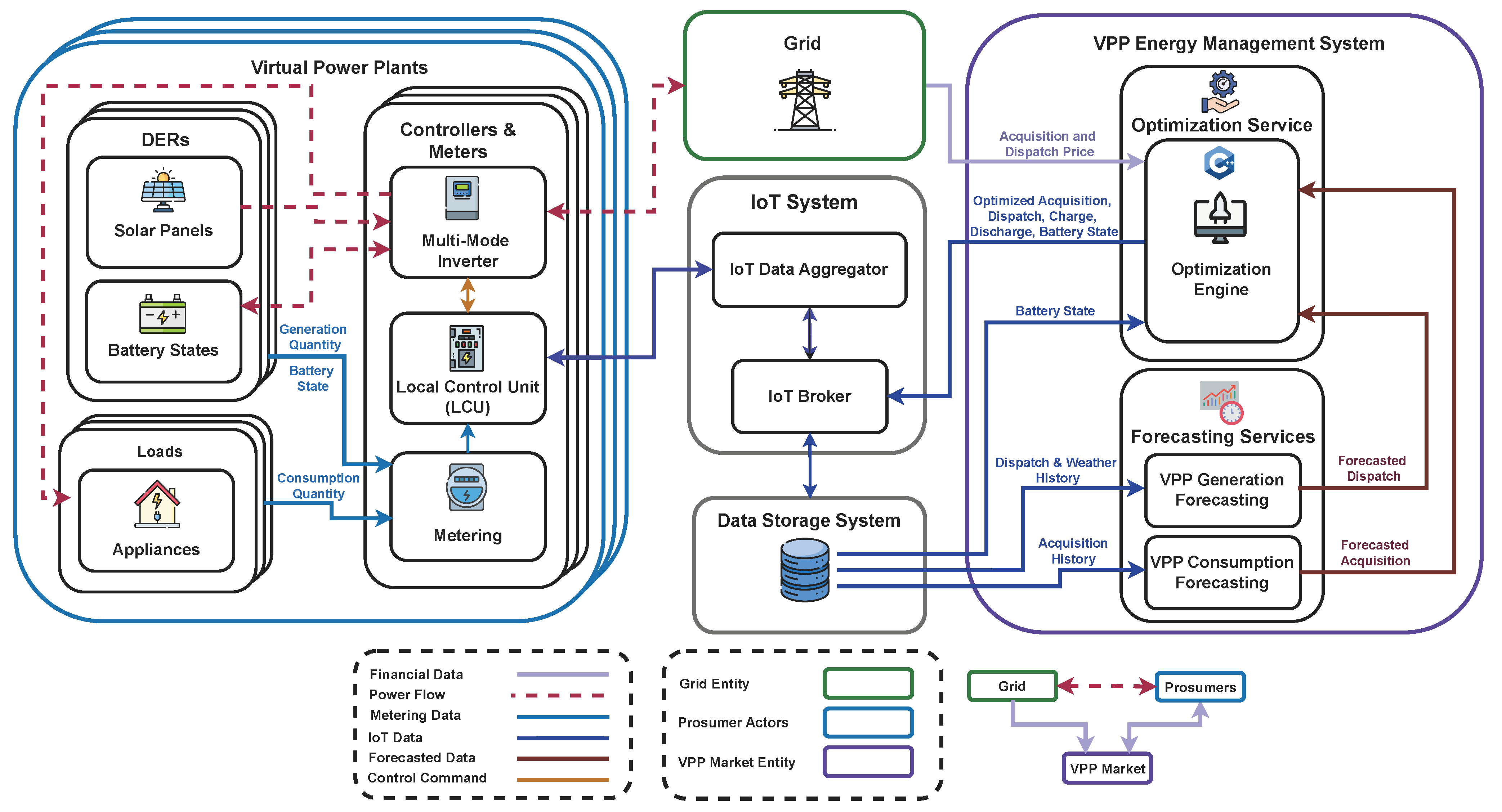
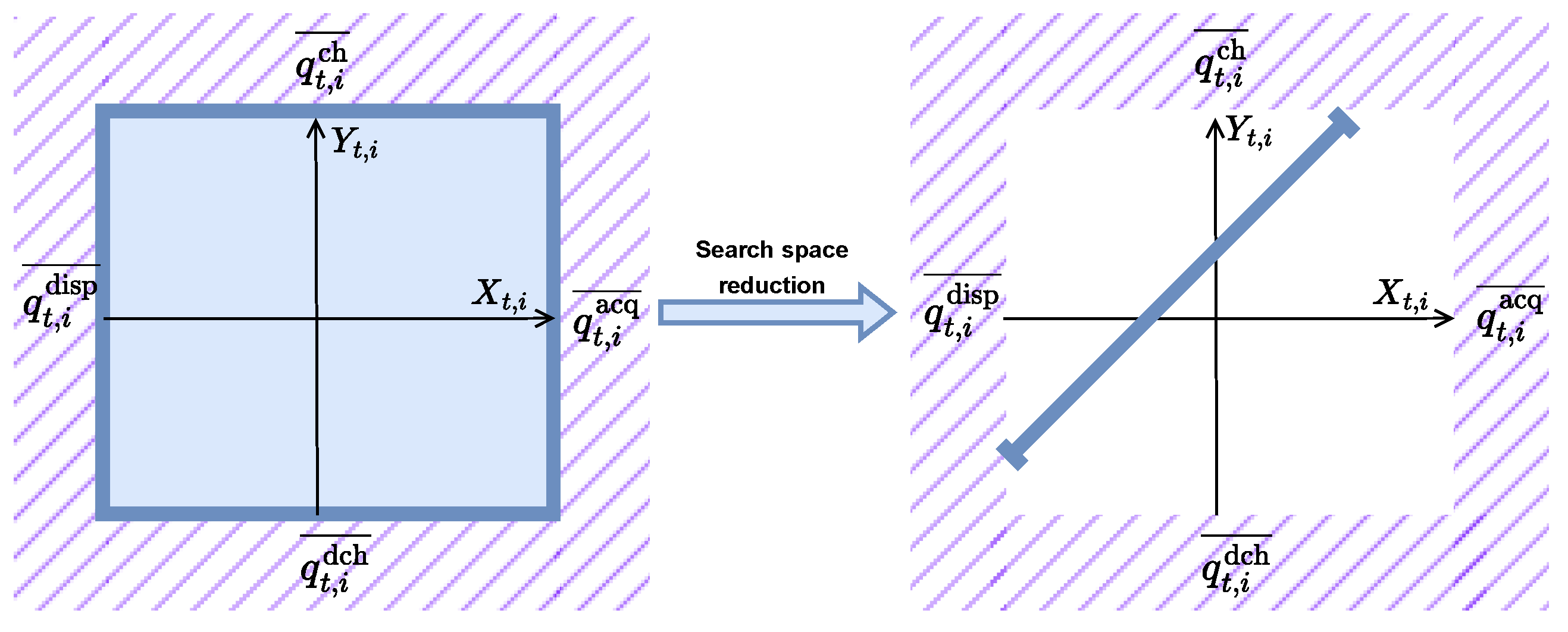
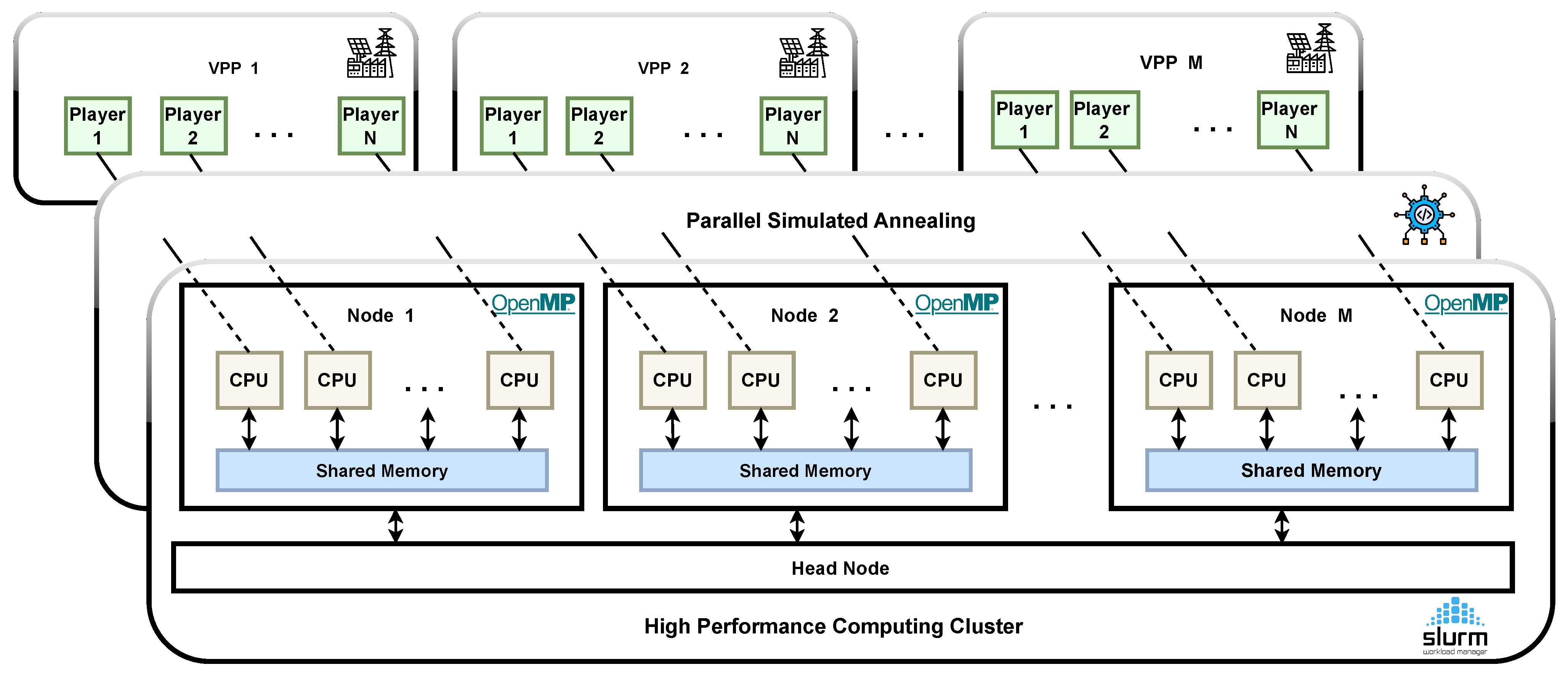
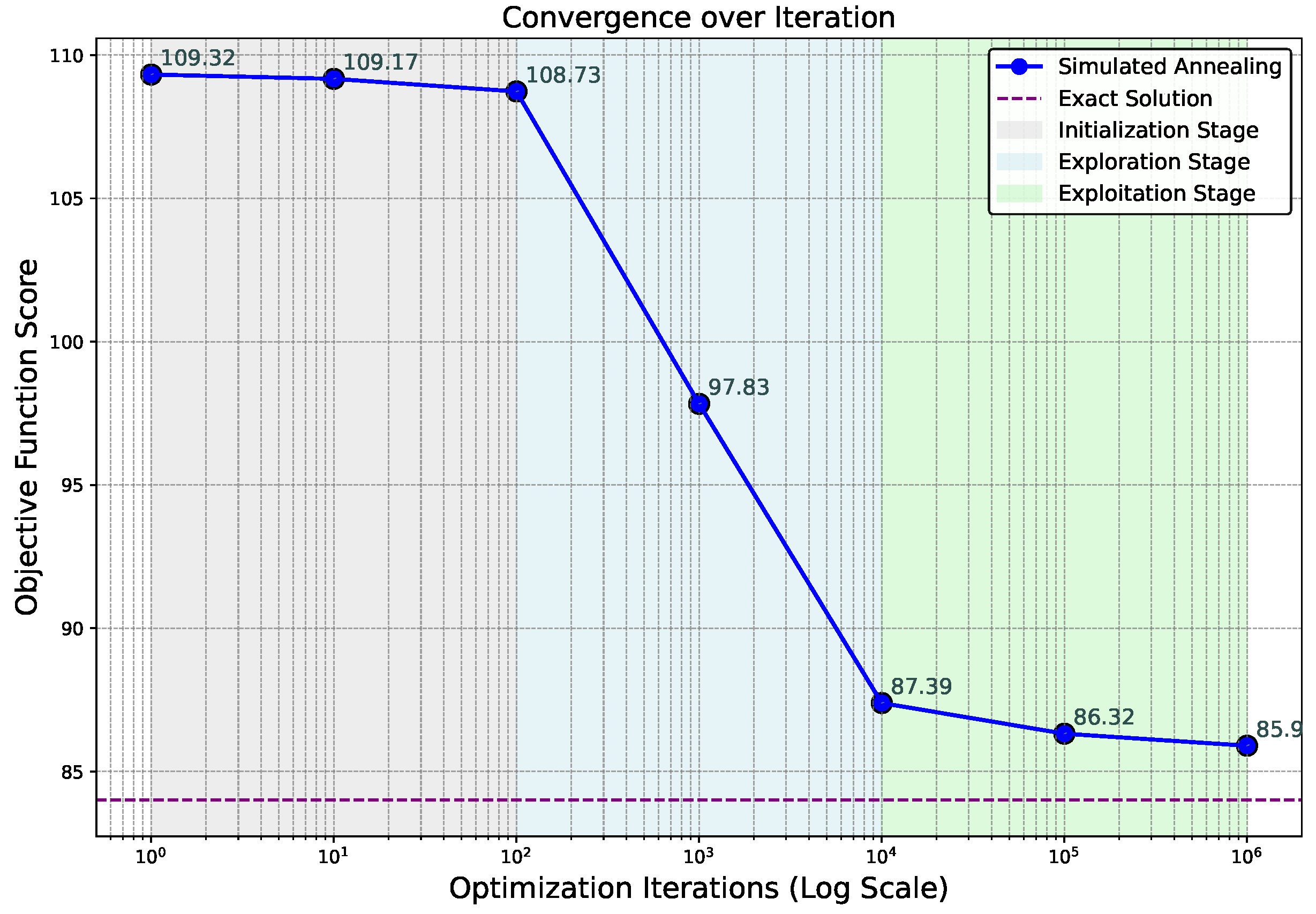
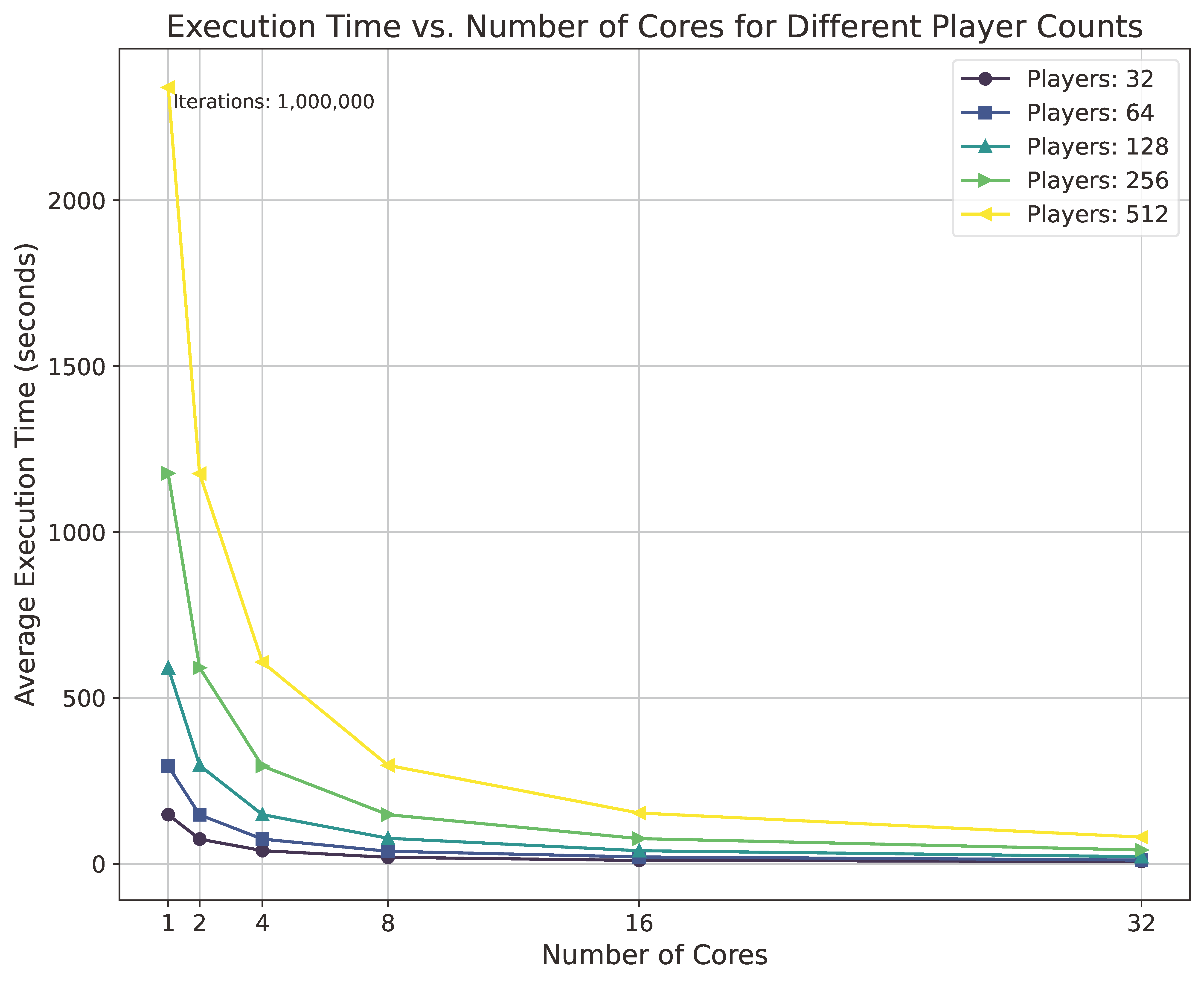
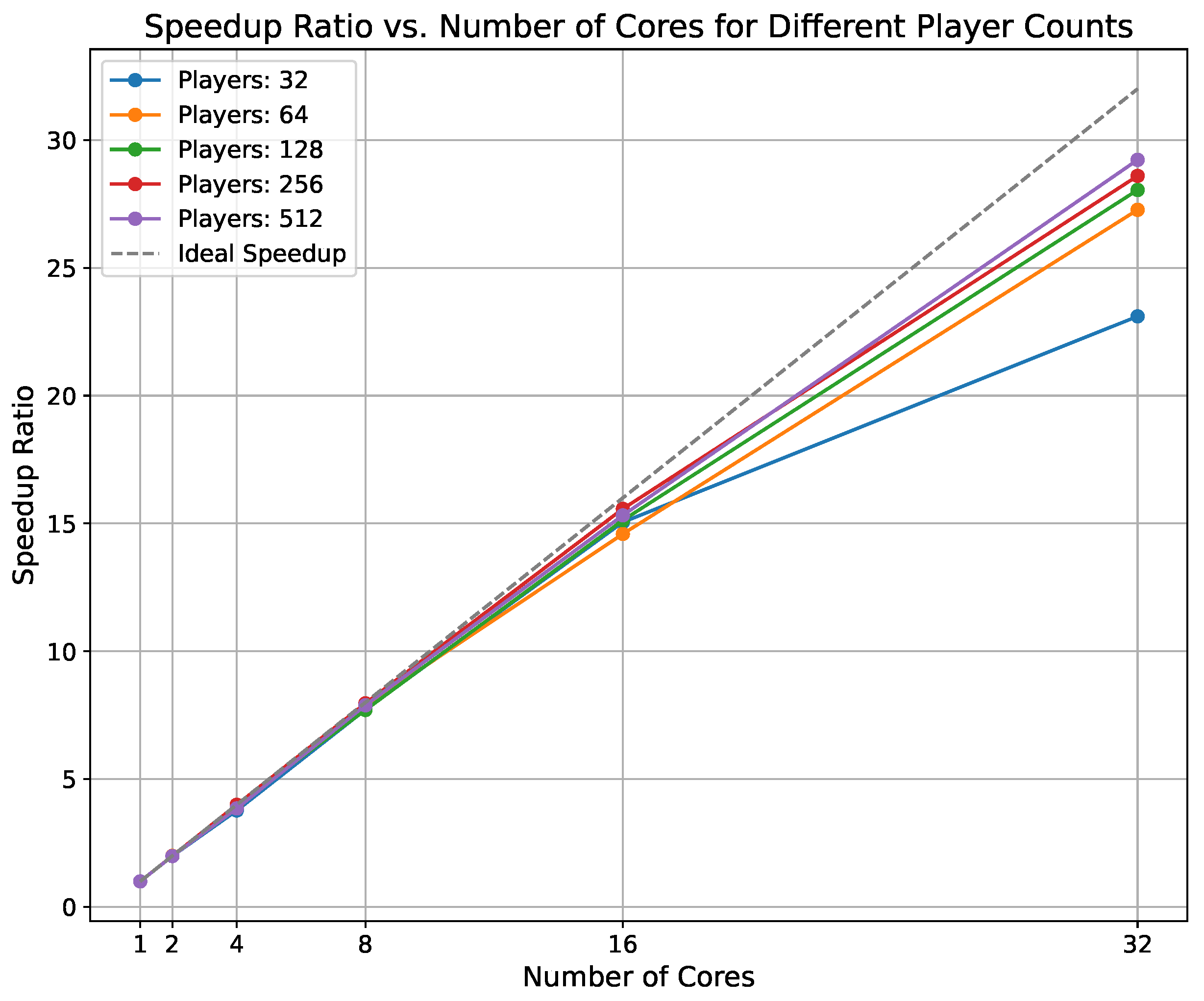
| Category | Symbol | Description | Type | Elements (in Vectors) |
|---|---|---|---|---|
| Parameters | Acquisition prices for energy per prosumer at time t | Vector | ||
| Dispatch prices per prosumer at time t | Vector | |||
| Battery-related costs | Scalar | - | ||
| Fixed operational costs | Scalar | - | ||
| Duration of each time period | Scalar | - | ||
| , | Maximum acquisition and dispatch limits per prosumer | Vectors | , | |
| , | Maximum charge and discharge limits per prosumer | Vectors | , | |
| Initial battery state per prosumer | Vector | |||
| , | Battery capacity limits (min, max) per prosumer | Vectors | , | |
| Generated energy per prosumer at time t | Vector | |||
| Energy load consumption per prosumer at time t | Vector | |||
| Energy acquisition amounts at time t | Vector | |||
| Energy dispatch amounts at time t | Vector | |||
| , | Battery charge and discharge amounts per prosumer at time t | Vectors | , | |
| Battery state at time t | Vector | |||
| Paid and non-paid energy dispatch per prosumer at time t | Vectors | , | ||
| Acquisition indicator per prosumer at time t | Binary Vector | |||
| Dispatch indicator per prosumer at time t | Binary Vector | |||
| Charge indicator per prosumer at time t | Binary Vector | |||
| Discharge indicator per prosumer at time t | Binary Vector |
| Parameter | Designation | Value Range | Unit |
|---|---|---|---|
| Total periods | 96 | - | |
| Number of players | 20–1000 | - | |
| Duration per period | h | ||
| Initial battery state | 0–1.92 | kWh | |
| Minimum battery level | 0–1.824 | kWh | |
| Maximum battery level | 0–9.6 | kWh | |
| Max charge rate | 0–5 | kWh | |
| Max discharge rate | 0–5 | kWh | |
| Max acquisition amount | 4.6–13.8 | kWh | |
| Max dispatch amount | 4.6–13.8 | kWh | |
| Fixed operational costs | 0.2197–0.6249 | EUR | |
| Generated energy forecast | 0–8.474 | kWh | |
| Consumed energy forecast | 0.050–9.822 | kWh | |
| Acquisition price | 0.1034–0.2314 | EUR/kWh | |
| Dispatch price | 0.045 | EUR/kWh |
| Parameter | Description | Unit |
|---|---|---|
| Energy amounts to be bought at time t | kWh | |
| Energy amounts to be sold at time t | kWh | |
| Energy amounts to be discarded (non-paid) | kWh | |
| Energy amounts to be charged to the battery | kWh | |
| Energy amounts to be discharged from the battery | kWh | |
| Total energy amounts to be exported | kWh | |
| Resulting battery states at time t | kWh |
| Optimization Method | Optimal Parameters | Best Score |
|---|---|---|
| Gaussian Process Minimization | [400.0, 0.85, 0.077] | 85.77 |
| Random Forest Minimization | [189.44, 0.895, 0.065] | 85.83 |
| Gradient-Boosted Regression Tree Minimization | [228.89, 0.959, 0.072] | 85.78 |
Disclaimer/Publisher’s Note: The statements, opinions and data contained in all publications are solely those of the individual author(s) and contributor(s) and not of MDPI and/or the editor(s). MDPI and/or the editor(s) disclaim responsibility for any injury to people or property resulting from any ideas, methods, instructions or products referred to in the content. |
© 2025 by the authors. Licensee MDPI, Basel, Switzerland. This article is an open access article distributed under the terms and conditions of the Creative Commons Attribution (CC BY) license (https://creativecommons.org/licenses/by/4.0/).
Share and Cite
Abbasi, A.; Alves, F.; Ribeiro, R.A.; Sobral, J.L.; Rodrigues, R. Optimizing Virtual Power Plants with Parallel Simulated Annealing on High-Performance Computing. Smart Cities 2025, 8, 47. https://doi.org/10.3390/smartcities8020047
Abbasi A, Alves F, Ribeiro RA, Sobral JL, Rodrigues R. Optimizing Virtual Power Plants with Parallel Simulated Annealing on High-Performance Computing. Smart Cities. 2025; 8(2):47. https://doi.org/10.3390/smartcities8020047
Chicago/Turabian StyleAbbasi, Ali, Filipe Alves, Rui A. Ribeiro, João L. Sobral, and Ricardo Rodrigues. 2025. "Optimizing Virtual Power Plants with Parallel Simulated Annealing on High-Performance Computing" Smart Cities 8, no. 2: 47. https://doi.org/10.3390/smartcities8020047
APA StyleAbbasi, A., Alves, F., Ribeiro, R. A., Sobral, J. L., & Rodrigues, R. (2025). Optimizing Virtual Power Plants with Parallel Simulated Annealing on High-Performance Computing. Smart Cities, 8(2), 47. https://doi.org/10.3390/smartcities8020047






